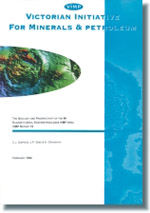VIMP Report 19 - The geology and prospectivity of the Mt Elizabeth area, Eastern Highlands VIMP area
 |
| |||||||||||||||
Product description:Download The downloadable version of this report is supplied in PDF format. Abstract This report describes the geology of the area covered by the Mount Elizabeth 1:50 000 map sheet, with particular emphasis on the Palaeozoic succession. The Mount Elizabeth 1:50 000 map sheet falls mainly within the Tabberabbera Zone of the Lachlan Fold Belt and is separated from the Omeo-Wagga Metamorphic Complex in the northern part of the map sheet by the Ensay Shear Zone. The Ordovician rocks on the Mount Elizabeth 1:50 000 map sheet are an undifferentiated sequence of mainly quartzose deep marine turbidites (Hotham Group), consisting of interbedded sandstone, mudstone and minor chert. Conodonts and a single graptolite locality indicate a Lower Ordovician age for these rocks. Large masses of tonelite and granodiorite intruded the Ordovician sequence in the northern half of the Mount Elizabeth 1:50 000 map sheet during the Middle to Late Silurian, prior to the commencement of mainly silicic volcanism in the Early Devonian which led to the accumulation of the Snowy River Volcanics within the Buchan Rift. The earliest recorded activity in the Buchan Rift was reworking of older rocks on the rift margin and deposition of an upward coarsening sequence of mudstone, quartz sandstones and conglomerate (Wilkinson Creek Formation). Eruption of the Fainting Range Ignimbrite led to the development of a small outlying caldera in the Mount Elizabeth 1:50 000 map sheet. A second ignimbrite (Slater Ignimbrite), intercalated within the Fainting Range Ignimbrite, is a probable outflow sheet derived from the main belt of Snowy River Volcanics. Small volumes of lava were also erupted and short-lived lakes that developed during breaks in the ignimbrite eruption are recorded by lenses of graded volcanic sandstone and mass flow deposits. Asymmetrical collapse of the volcanic pile occurred along an inner vertical ring fault, and granite plutons (Saint Patricks Creek Granite) and dykes were emplaced along two outer ring faults. Later caldera resurgence led to the emplacement of the high level Mount Elizabeth Granodiorite within the up-domed central collapsed block of volcanic rocks. Younger rocks in the Mount Elizabeth 1:50 000 map sheet include the probable Mid to Late Devonian Colquhoun Granite, one or more suites of lamprophyre and basaltic dykes of unknown age, Tertiary fluvial sediments related to the uplift and erosion of the East Victorian Uplands and fluvial sediments associated with the present courses of the Tambo-Timbarra river system. The Palaeozoic rocks in the Mount Elizabeth 1:50 000 map sheet have been affected by three regionally significant episodes of deformation. The Early Silurian Benambran Orogeny produced large-scale, east-west trending folds in the Ordovician rocks. Subsequent Mid Silurian to Early Devonian deformation during the Bowning Orogeny, involved dextral shearing and was mostly localised within the Ensay Shear Zone in the Mount Elizabeth 1:50 000 map sheet and regionally along the Kiewa Fault. The Ensay and Tambo Crossing Tonelites and the Kenny Creek Diorite and other related bodies intruded during this deformation phase. The Middle Devonian Tabberabberan Orogeny resulted in an intense foliation developed along a NW trending zone south of the Tambo Crossing Tonalite that may represent a southern extension of the Kiewa Fault. Associated deformation included refolding of the F1 folds along north-south axes, producing elongate basin and dome fold-interference patterns, and late brittle deformation features. The post-Palaeozoic history of the Mount Elizabeth 1:50 000 map sheet records a long stable period of deep weathering prior to the initiation of rifting that led to the eventual separation of Australia and Antactica during the Mesozoic and Tertiary. Uplift and erosion of the East Victorian Uplands during the Tertiary is reflected in the Mount Elizabeth 1:50 000 map sheet by deposits of Tertiary sand and gravel that mark the course of the ancestral Tambo-Timbarra river system. Geophysical data from the the Geological Survey of Victoria 1994 Orbost airborne magnetic and radiometric survey have been interpreted in order to provide information on the geophysical characteristics of the rock units mapped on the Mount Elizabeth 1:50 000 map sheet, and to complement the geological interpretation. Bibliographic reference Simpson, C.J., Sims, J. & Oranskaia, A., 1996. The geology and prospectivity of the Mt. Elizabeth area, Eastern Highlands VIMP area. Victorian Initiative for Minerals and Petroleum Report 19. Department of Agriculture, Energy and Minerals. Related products:
| ||||||||||||||||


